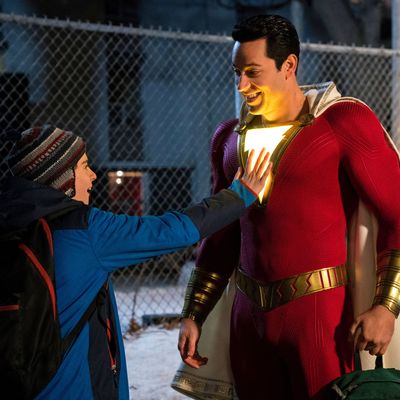
DC’s Shazam! has a genial sloppiness that might remind you of the days (if you can remember them) when the fates of studios didn’t rest on the ability of one or two B movies with men in goofy suits to generate billions in revenue. And it evokes something even further back: a time when superhero comics seemed genuinely liberating, a relief from a culture that relegated fantasies of magical transcendence to the realm of “kids’ stuff.” That was, of course, before fantasy became the ruling aesthetic and Marvel and DC began to suck up studio resources — before this crap became oppressive.
So Shazam! feels blessedly old-fashioned, which isn’t to say it’s perfect — or even very good. It’s certainly fun when the juvenile actors are front and center, before the CGI moves in for the last half-hour and change. The conflict at the center is one of our species’ great challenges: how to cope with lousy parenting. The hero, Billy Batson (Asher Angel), had an absent father and was separated from his mother at an early age, but even as a 14-year-old delinquent he clings to the hope of a reunion. He has a pure-ish heart, which means he’s at least half qualified to inherit the powers of the aged, hoary, histrionic Wizard Shazam (Djimon Hounsou, who’s like something out of Monty Python and the Holy Grail) — the last Shazam protecting the world from an invasion of the Seven Deadly Sins. (Silly me: I thought they’d been around for eons.) In contrast, the villain, Dr. Thaddeus Sivana (Mark Strong), was belittled by his smarmy dad (John Glover) and rejected by the Wizard. He has spent his life determined to find the portal back to the Wizard’s mystical realm, not to serve Shazam but to be a vessel for those deadly sins — a supervillain.
Shazam! is held together by the idea that a healthy family is possible, here in the form of two sunny foster parents who brightly welcome Billy and support a menagerie of adorable misfits of different ages, genders, and races. The little scene-stealer is Darla (Faithe Herman), who bonds instantly with Billy in a way that might — with a twist of emphasis — have seemed creepy. But the most powerful presence is Freddy Freeman (the dark-browed Jack Dylan Grazer), a kid with a bum leg and a drawer full of Superman and Batman memorabilia. (Shazam! makes a vigorous attempt to take our minds off the fates of Iron Man, Thor, Captain America, et al. — not easy with this crowd.) Hobbled and relentlessly bullied, Freddy can’t believe that Billy isn’t over the moon to acquire superpowers and the responsibility of saving the world. Not to mention that he can kick bully ass. Frankly, I couldn’t believe it either, but mostly because Billy suddenly isn’t Billy.
Angel Asher does not, as you might know, play the adult superhero who appears when he says, “Shazam!” It’s a stark disappointment when Zachary Levi and his muscles show up, not just because Levi is less magnetic than Angel but because he doesn’t seem to be playing the same character. Didn’t the director, David F. Sandberg, get the two actors together to work on some common moves? Angel’s Billy is wary, over-defended — he has had to grow up too fast. But Levi’s shtick is the schism between the adult super-body and childish emotions that Angel hasn’t ever displayed. It’s funny when Shazam discovers his range of powers (the best part of most superhero “origin” films) and when he gets giddy at the thought of buying beer or going into a strip club, but not when he pules and cringes and acts like a preteen.
He’s such a whiny pill that it’s a relief when Shazam says “Shazam!” and turns back into Billy. Angel is so much more grounded, especially when he finally finds his long-lost mother and comes up with a new definition of family. This kid has some acting chops.
Sandberg and screenwriter Henry Gayden know what they have and what they don’t have — i.e., the resources of a top-tier superhero movie. But the film’s summer-stock vibe often works for it. Superman lives in the towering Metropolis, Batman the Expressionistic Gotham City. Shazam! is set in Philadelphia, so one’s expectations are naturally lowered. The kid actors do a good job of suggesting that they like being in one another’s company, if not necessarily in Philadelphia.
But it’s a bummer when the bad guy shows up and Shazam becomes like every other superhero movie — worse, really, because the storyboarding is so poor that it’s hard to tell what’s going on. In the climax, Sandberg misses nearly every one of his marks. A wedgie joke that ought to kill goes by so fast it barely registers, and you can hardly tell the snarled, cartoonish deadly sins apart. I felt pain watching Mark Strong bellow the standard supervillain taunts at Shazam — I really thought he’d be a major film actor someday. The most disappointing thing is that the kids are replaced by grown-up actors we haven’t gotten to know and who are shot in a way that guarantees that we never will. It’s another disconnect. By then Shazam! has earned enough goodwill that audiences will probably be inclined to go with the flow — if only the flow flowed.


